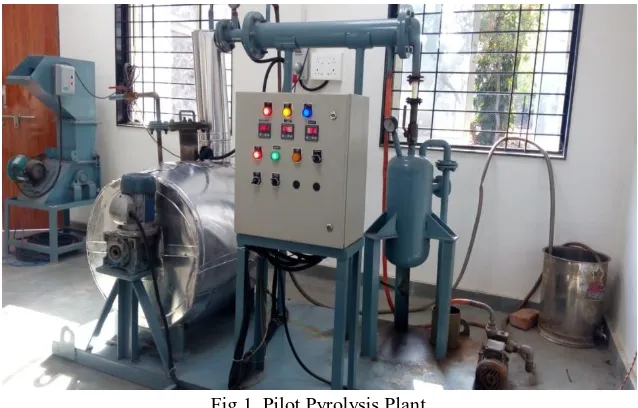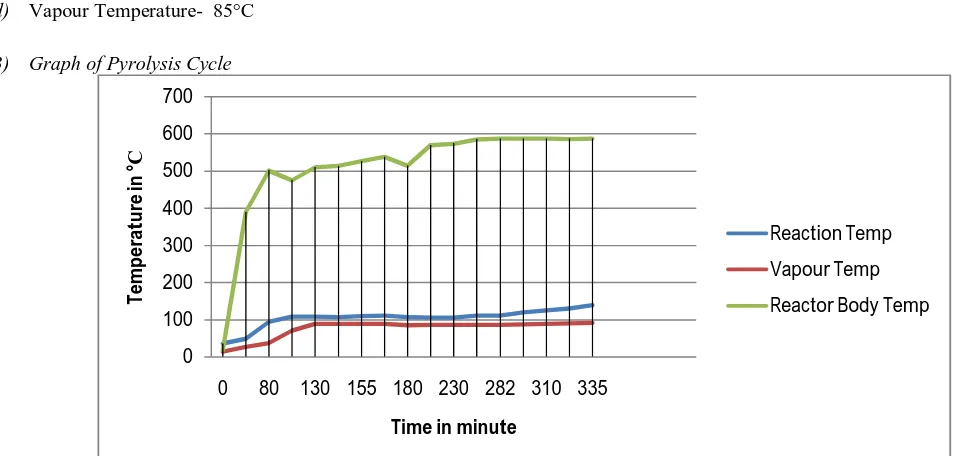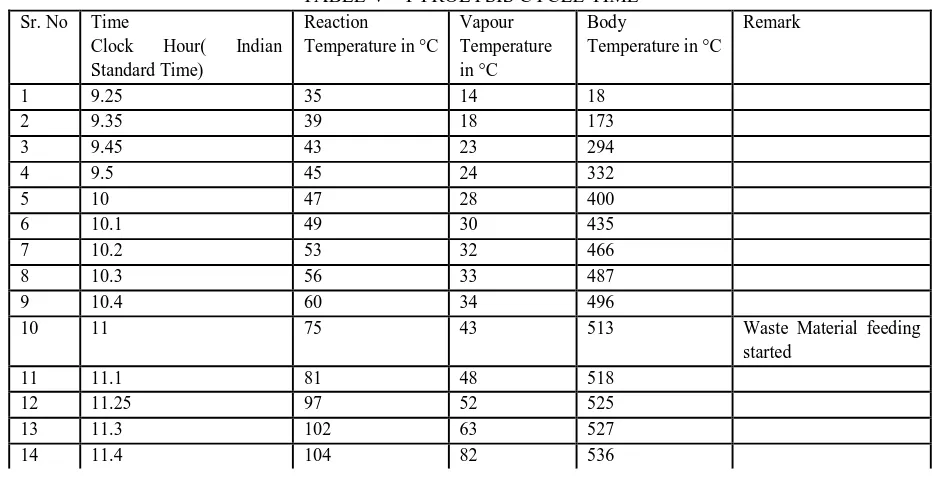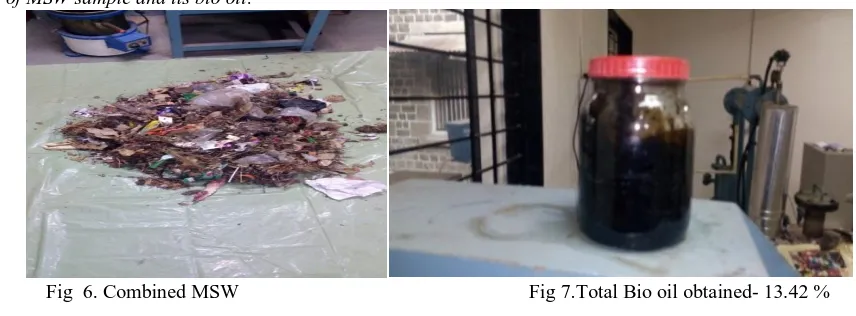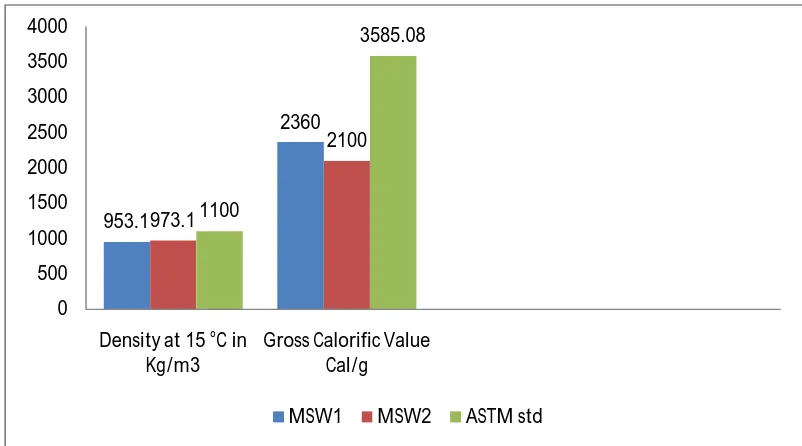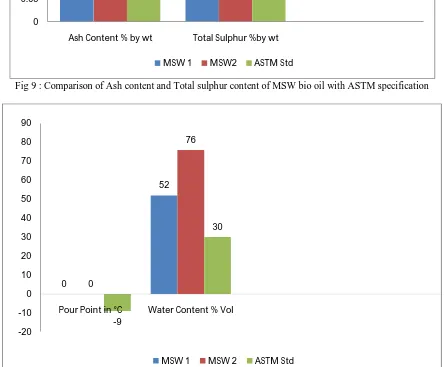6
I
January 2018
Pyrolysis of Municipal Solid Waste
Swanand B. Kulkarni1, Mahadeo S. Ranadive2
1
Research Scholar, 2 Associate Professor, Department of Civil Engineering, College of Engineering, Pune 411005, India)
Abstract: Generally asphalt used by the paving industries today is obtained by processing the crude oils. The price of the crude oil is influenced by the demand of the different grade of crude oil. Due to high prices of crude oil, the price of asphalt binder has increased tremendously. So scientist are looking for the alternative binders and the bio-oil obtained by pyrolysis of municipal solid waste (MSW), is one of them, which can be best utilized for road construction due to which the environmental pollution get reduced and the problem of disposal of MSW get minimized.In view of search of alternative binder for flexible pavement, a research study on ‘Effective use of bio oil obtained by pyrolysis of municipal solid waste in flexible pavement’ is under taken. The pilot pyrolysis machin of capacity 10 Kg is developed at Transportation Engineering laboratory of Collage of Engineering, Pune. The machine contains reactor, feeder pipe, vapour line, condenser pipe, reciever of bio oil etc. The pyrolysis of various samples of combined municipal solid waste (msw) and waste plastic bags are carried out. It is noticed that the pyrolysis of combined msw occurs at maximum reactor external température of 450°C to 550°C where as the inside température of reactor at which reaction occurs is observed within range of 100°C to 110°C and vapour line temperature was observed between 85°C to 90°C. The various characteristic of bio oil obtained from combined msw are checked. The time study of pyrolysis cycle is taken in which the temperature of reactor, vapour line temperature and inside temperature of reactor are recorded at certain time interval. The physical and chemical characteristics of bio oil of msw shows the ressemblance with the characteristics of bio fuel and bitumen. Due to high water content, the tests of kinematic viscosity and flash point couldnot be conducted. Before testing, removal of water content by distillation of sample is essential. The calorific values will improve after removal of excess water content in bio oil. The FTIR spectra shows the alophatic carboxylic acids and aliphatic hydrocarbons groups which are also present in chemical composition of bitumen. There is future scope for further research and experiments to find out the effective utilization of msw bio oil for replacement of bitumen in flexible pavement.
Keywords: Pyrolysis, bio-oil, msw, reactor temperature, kinematic viscosity
I. INTRODUCTION
The bitumen used in flexible pavement is obtained from petroleum crude oil. The price of bitumen is increasing day by day. The petroleum crude oil is one of the natural resources and the natural resources are depleting. We need to conserve natural resources. There is huge consumption of bitumen for flexible pavement in all over India. Therefore there is always a search of alternative binder. In Iowa State University, the efforts had been taken to use the bio oil of switch grass, oak wood, cornstover is obtained by pyrolysis to replace bitumen.[2] On the observation of this study, further research is undertaken on the topic ‘Effective use of bio oil obtained by pyrolysis of municipal solid waste in flexible pavement’
On the other hand we are facing serious environmental issues due to generation of municipal solid waste in huge quantities. There is no disposal system effectively working. Because of which we are facing problems of health hazards and pollution in all over India. Huge land is occupied for storage due to dumping of municipal solid waste. In order to control the increasing problems of waste, pyrolysis is one of the popular method coming up for pollution free disposal of municipal solid waste. In this method, thermal decomposition is done in absence of oxygen.
The bio oil is produced along with carbon black powder and uncondensed gas. It is proposed to use this bio oil as alternative binder. At the optimum temperature of pyrolysis, maximum out put of oil is obtained.
The municipal solid waste generally contains organic waste, paper, glass, metal, plastic, textile etc ingredients. The glass and metal are separated out and are reused. The plastic household containers and thick plastic bags such as milk bags are also reused. The rest of the waste contains organic waste with plastic thin carry bags, plastic packaging pouches of biscuits, wafers etc, pieces of textile waste, pieces of papers etc.
II. MATERIALS AND METHODS
A. Equipment Details
[image:3.612.147.466.270.474.2]A set up of pilot plant of pyrolysis of maximum capacity 10Kg is established at laboratory level. The plant contains reactor, vapour pipe line, condenser pipe, oil receiver, feeder pipe, oil receiving tap etc components. The reactor is made up of material SS316 of dimensions40 cm dia and 75 cm in length. The reactor is surrounded by a coil at a gap of 50 mm from external surface of reactor to which the electrical supply is provided and the reactor is heated by radiation. Three phase electrical supply is provided through the control panel on which the digital readings of various temperatures such as reactor body temperature, inside temperature of reactor and vapour line temperature could be displayed. Three different probes are fitted to sense these temperatures. Maximum temperature of reactor can be reached up to 900°C. The pressure gauge is provided at vapour line to measure and ensure low pressure upto 0.001 mmHg. Water jacketing is provided for effective condensation of vapours. The reactor is fixed whereas the staft with impeller is rotating in forward and reverse direction, the drive is being given through motor and gear box. The feeder pipe of ID 80mm is fitted to reactor thru which the waste material is inserted. A receiver is provided to collect the oil. At the top of receiver an exit pipe is provided to release the uncondensed gases. These gases are allowed to leave into water in order to avoid air pollution. In bigger capacity plants, the uncondensed gases are stored in balloons and reused for heating purpose. At one end of reactor a window with stutter is provided to remove carbon generated in pyrolyis .
Fig 1. Pilot Pyrolysis Plant
The pyrolysis process carried out for 11 different samples of Municipal Solid Waste collected from Karad City of Maharashtra State. The samples were collected from different locations and in different seasons. The usable waste material was already separated out and the rest of the waste was dumped in dumping yard.
B. Experimental Procedure
The samples of municipal solid waste were kept in solar heat for drying. Before pyrolysis the weights of different ingredients in msw are recorded. Ideally waste material shall be cut into small pieces, but in this case pyrolysis was done by processing the material as it was received. The labour involved for segregation and to cut into pieces is more. In actual practice, the segregation at dumping yard and its cutting is time taking and costly. To avoid this, experiment was conducted by processing the msw without cutting into small pieces.
In present study the pyrolysis using reactor described was carried out at 450°C to 550°C at very low pressure with rate of heating 15 °C/min. The waste is converted into bio oil, solid carbon powder and uncondensed gas.
The detail process of pyrolysis of two samples is discussed in this paper along with its time study of pyrolysis cycles. The physical properties of bio oil are checked.
III. OBSERVATIONS
A. Pyrolysis details of various samples of MSW
TABLE I. PYROLYSIS OF VARIOUS SAMPLES OF MSW Sr No Type of Waste processed for
Pyrolysis
Quantity of Waste in Kg
Maximum quantity of Bio Oil obtained in %
The temperature of reactor at which Bio oil generation started in°C
1 Household Plastic from MSW 2.469 34 541
2 Combined MSW 2.8 13.39 540
3 Combined MSW 5.6 14.48 515
4 Combined MSW 3.727 13.42 550
5 Combined MSW 3.624 13.32 540
6 Combined MSW 4.603 25.52 543
7 Combined MSW 3.048 32.91 540
8 Wet Organic Sample 3.265 36.97 493
9 Dry Organic Sample 1.8 47.72 500
10 Combined MSW 2.017 18 544
11 Semidry Organic Waste 2.079 43 546
In the pyrolysis of combined msw, the maximum out put of bio oil was 32.91%, in case of organic waste it was 47.72 % and in case of household plastic containers from msw it was 34%. The range of temperature at which pyrolysis reaction occurred and the bio oil generation started was from 493°C to 550°C .
The details of pyrolysis cycle of two samples of msw are studied. The sample was segregated and weights of different ingredients are noted.The time study of pyrolysis cycle is taken in which the température of reactor, vapour line temperature and inside temperature of reactor are recorded at certain time interval.
B. Pyrolysis of MSW- Sample 1 ( MSW1)
Sample – Combined Municipal Waste Collection Site- MSW depot, Karad Quantity of waste- 5.600 Kg
Quantity of Bio oil obtained - 0.811 Kg – 14.48 %
1) Different Ingredients of MSW sample and its proportion
TABLE II . INGREDIENTS MSW 1
Sr No Waste Ingredients Weight in Kg % of total waste
1 Plastic Bags 0.685 12.23
2 Textile Waste 0.212 3.79
3 Leather Waste 0.138 2.46
4 Rubber sole of footware 0.269 4.8
5 Paper Waste 0.126 2.25
6 Organic Waste & Miscellaneous 4.17 74.47
Note - Sample Collected from MSW dumping yard, Karad, M..S.( India) The sample was collected in the month May 2017. It was kept for dryng in solar heat for the period of three weeks and processed for pyrolysis on 09.12.2017. The sample was dry at the time of pyrolysis.
[image:5.612.37.580.148.427.2]2) Pyrolysis Cycle Time Study
TABLE III PYROLYSIS CYCLE TIME Sr.
No
Time Clock Hour (Indian Standard Time)
Reaction Temp in °C
Vapour Temp in °C
Body Temp in °C
Remark
1 9.55 36 15 19
2 10.25 49 28 390
3 11.15 95 38 502 Waste Material feeding started
4 11.4 109 71 476
5 12.05 109 90 510 Emission of uncondensed gases
started thru exit pipe.
6 12.2 108 89 514
7 12.3 110 89 527
8 12.45 111 89 539
9 12.55 107 85 515 Bio oil obtained approx - 0.50 Kg
10 13.35 106 87 570
11 13.45 106 87 574
12 14.15 111 87 586
13 14.37 112 87 588
14 14.47 120 88 588
15 15.05 126 89 588
16 15.15 131 91 587
17 15.4 140 92 588 Bio oil obtained 0.811 Kg - 14.48 %
From Table III it is noted that,
a) Pyrolysis Process Cycle Time for optimum yield – 3 Hrs
b) Reactor Temperature at max yield of bio oil - 515°C
c) Reaction Temperature – 107 °C
d) Vapour Temperature- 85°C
3) Graph of Pyrolysis Cycle
Fig 2. Time v/s Temperature of Reaction, Vapour Line, Reactor Body
0 100 200 300 400 500 600 700
0 80 130 155 180 230 282 310 335
Te m p e ra tu re in ° C
Time in minute
Reaction Temp
Vapour Temp
[image:5.612.44.530.491.719.2]Fig 3. Combined MSW -- 5.600 Kg Fig 4.Total Bio oil obtained- 0.811 Kg – 14.48 %
C. Pyrolysis of MSW Sample 2 (MSW 2)
Sample- Combined Municipal Solid Waste – Semidry Collection spot- MSW Depo Karad
Quantity of Waste- 3.727 Kg
Quantity of Bio Oil obtained – 0.50 Kg – 13.42 %
[image:6.612.72.539.335.436.2]1) Different Ingredients of MSW sample and its proportion:
TABLE IV. INGREDIENTS OF MSW 2
Sr. No Waste Ingredients Weight in Kg % of Total waste
1 Plastic waste 0.317 8.5
2 Textile Waste 0.48 12.89
3 Leather Waste 0 0
4 Paper Waste 0.387 10.38
5 Organic Waste & Miscellaneous 2.543 68.23
Total 3.727 100
Note –The sample was collected in the month Oct 2017. It was kept for dryng in solar heat for the period of three weeks and processed for pyrolysis on 15.12.2017. The sample was dry at the time of pyrolysis.
2) Pyrolysis Cycle Time Study:
TABLE V PYROLYSIS CYCLE TIME
Sr. No Time
Clock Hour( Indian Standard Time)
Reaction
Temperature in °C
Vapour Temperature in °C
Body
Temperature in °C
Remark
1 9.25 35 14 18
2 9.35 39 18 173
3 9.45 43 23 294
4 9.5 45 24 332
5 10 47 28 400
6 10.1 49 30 435
7 10.2 53 32 466
8 10.3 56 33 487
9 10.4 60 34 496
10 11 75 43 513 Waste Material feeding
started
11 11.1 81 48 518
12 11.25 97 52 525
13 11.3 102 63 527
[image:6.612.71.539.503.747.2]15 11.52 101 79 543
16 12.02 103 90 550 Bio-oil obtained
17 12.15 103 88 557
18 12.2 106 89 560
19 12.3 106 91 564
20 12.4 109 91 563
21 12.45 110 92 563
22 12.55 112 94 566
23 13.1 115 95 575
Bio oil obtained - 0.500 Kg - 13.42 %
From Table V it is noted that ,
a) Pyrolysis Process Cycle Time for optimum yield – 2.5 Hrs
b) Reactor Temperature - 550°C
c) Reaction Temperature – 103 °C
d) Vapour Temperature- 90°C
[image:7.612.130.511.308.468.2]3) Graph of Pyrolysis Process Cycle
Fig 5.Time v/s Temperature of Reaction, Vapour Line, Reactor Body
[image:7.612.87.515.504.662.2]4) Images of MSW sample and its bio oil:
Fig 6. Combined MSW Fig 7.Total Bio oil obtained- 13.42 %
IV. RESULTS AND DISCUSSION
From the above two pyrolysis cycles of Municipal Solid Waste samples it is noticed that the pyrolysis of combined msw occurs at maximum external température of reactor between 450°C to 550°C where as the inside temperature of reactor at which reaction occurs is observed within range of 100°C to 110°C and vapour line temperature was observed between 85°C to 90°C. After recieving bio oil, if the heating is continued , the temperature of reactor goes on increasing. The total pyrolysis process continues
0 100 200 300 400 500 600 700
0 20 35 55 75
1 0 5 1 2 5 1 4 7 1 7 0 1 8 5 2 0 0 2 2 5 T em p e ra tu re in ° C
Time in minute
Reaction Temperature
Vapour Temperature
from 2.5 Hr to 3 Hr. It is observed that the thermochemical reaction occurs within 30 to 35 minutes time But in case of contineous operation of pyrolysis, the heating time of reactor is reduced up to 60 minutes. This will save the energy required for pyrolysis.In above cases the quantity of bio oil are recorded as 14.48% and 13.42 % . But when the bio oil is settled in bottle for one or two hour it is noticed that there are two layers formed in oil, the top layer is of oil and bottom layer is of water. Apprximately 50 % water was found in total quantity of bio oil obtained. The water was removed before testing of bio oil
A. Characteristics of Bio oil derived from Combined Municipal Solid Waste-
1) Testing of various characteristics of bio oil derived from Pyrolysis of Combined MSW is carried out for above mentioned two
samples -MSW1 and MSW2
[image:8.612.64.546.223.439.2]2) The characteristics are compared with the ASTM D7544-12 specifications of liquid bio fuel, published in 2012.
TABLE VI . CHARACTERISTICS OF MSW BIO-OIL
Sr. No Test Description Unit MSW 1 MSW 2 Limit as per
ASTM D7544-12 Specifications
1 Density at 15 °C Kg/m3 953.1 973.1 1100 min
2 Gross Calorific Value Cal/g 2360 2100 3585.08 min
3 Flash Point deg C * * 45
4 Water Content % by Vol 52 76 30 max
5 Pour Point Deg C 0 0 -9 min
6 Ash Content % by wt 0.130 0.243 0.25 max
7 Kinematic Viscosity at
40°C
cSt * * 125 max
8 pH Value 4 4.20 -
9 Total Sulphur % by wt 0.196 0.209 0.05 max
10 Conradson Carbon
Residue
% by wt 0.84 1.71 -
*Because of high water content, the tests could not be conducted. The sample may require pre-heatening treatment before testing.
B. Graphical representation of Characteristics
The graphical comparison of various characteristics of bio oil of MSW1 & MSW2 with ASTM D 7544-12 specifications is shown in following charts.
Fig 8. Comparison of Density and Calorific value of MSW bio oil with ASTM specification.
953.1
2360
973.1
2100
1100
3585.08
0 500 1000 1500 2000 2500 3000 3500 4000
Density at 15 °C in Kg/m3
Gross Calorific Value Cal/g
[image:8.612.104.505.498.721.2]Fig 9 : Comparison of Ash content and Total sulphur content of MSW bio oil with ASTM specification
Fig 10 :Comparison of Pour Point and Water content of MSW bio oil with ASTM specification
C. Observations of comparative study with ASTM specifications-
The water content is comparatively higher in bio oil of MSW. Therefore the tests for important parameters like Kinematic Viscosity and Flash point could not be conducted. Before tests to be conducted, the bio oil sample need to be heated to remove the water content present in oil.
It is noted that, there is very little variation in characteristics of two different samples of bio oil of MSW. The characteristics of bio oil are depending upon the feedstock. There will be always variation in percentage contribution of various ingredients in the MSW, though the MSW samples are collected from same location. The quality of bio oil varies with the quality of feedstock.
The sulphur content found in bio oil of MSW is comparatively more than that of ASTM specification. The calorific values are found comparatively lower than that of ASTM standards, but those are likely to be improved if testing would be conducted by removing water content from the bio oil sample.
0.13
0.196 0.243
0.209 0.25
0.05
0 0.05 0.1 0.15 0.2 0.25 0.3
Ash Content % by wt Total Sulphur %by wt
MSW 1 MSW2 ASTM Std
0
52
0
76
-9
30
-20 -10 0 10 20 30 40 50 60 70 80 90
Pour Point in °C Water Content % Vol
[image:9.612.84.528.201.568.2]D. Chemical Characteristics of MSW Bio oil of MSW Sample No 2 –
Fig 11 FTIR Spectra of MSW Bio oil Fig 12. FTIR spectra of Bitumen
The Fourier Transform Infra Red ( FTIR ) test was conducted . The FTIR spectra of MSW Bio oil shows the group of aliphatic carboxylic acids and aliphatic hydrocarbon groups.( Fig 11) This spectra is matching with the spectra of bitumen. In chemical composition of ashalt or bitumen, these groups are found. Therefore the msw bio oil can be considered as an alternative or partial substitute for asphalt. There is further scope of research to find out the percentage of bio oil that can be used for replacement of bitumen or if any other polymer additives are essential to add in it to meet the properties of asphalt.
V. CONCLUSION
Pyrolysis appears to be an efficient thermo-chemical method to convert the municipal solid waste into bio oil and carbon black. The characteristics of msw bio oil shows interesting results and its comparison with ASTM standards have thrown a light on further line of direction of research. The following conclusions are drawn from this study.
1) Dark brown bio oil is obtained after pyrolysis of municipal solid waste.
2) Due to higher water content present in bio oil of msw, the important characteristics such as kinematic viscosity and flash point
could not be conducted. These are the important characteristic to be compared to check the similarity with bitumem.
3) Before pyrolysis, the municipal solid waste shall be heated with the maximum temperature around 60°C to 70°C to remove
moisture content. Also the preheatening treatment shall be given to the bio oil obtained.
4) In case of continuous operation of pyrolysis, the heating time of reactor is reduced upto 60 minutes. This will save the energy
required for pyrolysis.
5) The calorific values are moderate and might improve after removal of moisture content present in bio oil.
6) The density of msw bio oil found 12% to 13 % less than that of ASTM biofuel minimum standards.
7) The FTIR spectra shows aliphatic carboxylic acids and aliphatic hydrocarbon groups and the peaks are matching with the peaks
of FTIR spectra of bitumen. Also these groups are present in chemical composition of bitumen. Therefore the msw bio oil can be considered for partial replacement of bitumen. There is further scope of research in this aspect.
8) Further efforts required to be taken to check the characteristics by processing oven dried msw sample and compare its bio oil
with the characteristics of bitumen.
REFERENCES
[1] MdManiruzzaman A. Aziz ,MdTareq Rahman, Mohd. Rosli Hainin, Wan Azelee Wan Abu Bakar, “Alternative Binders for Flexible Pavement” UTM
Construction Research Center (CRC),Malaysia.
[2] Mohamed Abdel Raouf Mohamed Metwally,R. Christopher Williams, “Development of Non-Petroleum Based Binders for Use in Flexible Pavements,”
Report, IHRB Project TR-594,InTrans Project 08-133.2010.
[3] Noor Azah Abdul Ramana, Mohd Rosli Hainina, Norhidayah Abdul Hassana, Farid Nasir Anib “A Review on the Application of Bio-oil as an Additive for
Asphalt” 72:5 (2015) 105–110, ISSN 2180–3722.
[4] Mroueh, U. M. and Wahlström, M., “By-products and recycled materials in earth construction in Finland an assessment of applicability” Resources,
[5] Muhammad SaifulIslam, M. Yunus Miah, Mohammad Ismail, Mohammad Shah Jamal,Sujit Kumar Banik and Manoranjan Saha, “Production of Bio-Oil from Municipal Solid Waste by Pyrolysis”, Bangladesh Journal of Scientific and Industrial Research, 45(2),91-94,2010.
[6] Sady. A. Tayh , Ratnasamy Muniandy, Salihudin Hassim, FauzanJakarni, EltaherAburkaba, “An overview of utilization of bio-oil in hot mix asphalt”,
WALIA journal 30(S3): 131-141, 2014, ISSN 1026-3861,2014 WALIA.
[7] Vignesh H, Ramesh Babu N.G, Manivasagan V, Suganya S and, EajasBasha M. “ Emerging Trends in Greener Pavements”, International Journal of
Engineering Research & Technology (IJERT), Vol. 2 Issue 2, February- 2013.
[8] Rajendra Kumar Kaushal, George K. Varghese , Mayuri Chabukdhara, “Municipal Solid Waste Management in India-Current State and Future Challenges: A
Review”, International Journal of Engineering Science and Technology (IJEST), ISSN : 0975-5462 Vol. 4 No.04 April 2012.
[9] Joana Peralta, R. Christopher Williams, Marjorie Rover,Hugo M,R. D. Silva, “Development of Rubber-Modified Fractionated Bio-Oil for Use as Noncrude
Petroleum Binder in Flexible Pavements”,Trasportatuin Research Circular, E-C165: Alternative Binder
[10] M. Ringer, V. Putsche, and J. Scahill, “Large-Scale Pyrolysis Oil Production: A Technology Assessment and Economic Analysis” Technical Report National Renewable Energy Laboratory TP-510-37779 November 2006.
[11] D.O.Onyango and J. W. Kaluli, Pyrolysis: “An Alternative Technology For, Municipal Solid Waste Management” M. Ringer, V. Putsche, and J.
Scahill, “Large-Scale Pyrolysis Oil Production: A TechnologyAssessment and Economic Analysis “ Technical Report National Renewable Energy Laboratory/TP-510-37779 November 2006.
[12] R.P. Singha,d, V.V. Tyagib, TanuAllenc, M. HakimiIbrahimd, RichaKotharie, “ An overview for exploring the possibilities of energy generation from municipal solid waste (MSW) in Indian scenario”, Renewable and Sustainable Energy Reviews 15 (2011) 4797– 4808.
[13] J.Peralta; R.C. Williams, H.M.R.D. Silva and A.V. Machado, “ Combining -Asphalt –Rubber ( AR) and Fast Pyrolysis Bio-oil to Creat a Binder for Flexible
Pavement, WASTES: Solutions, Treatments and Opportunities,” 2nd International Conference , September 11th – 13th 2013.
[14] Mohammad I. Jahirul , Mohammad G. Rasul, Ashfaque Ahmed Chowdhury and Nanjappa Ashwath , “Biofuels Production through Biomass Pyrolysis” A
Technological Review, Energies 2012, 5, 4952-5001, ISSN 1996-1073.
[15] Y. Q. Liu, J.Wang, Z. Dong , J.H.Tay, “ Characterization of Pyrolysis Oil from Municipal Solid Waste”, Third International Conference on Industrial and
Hazardous Waste Mnagement- CRETE 2012.
[16] Rongsheng Ruan, Changyan Yang, Bo Zang, Xiangyang Lin,Ling Chen,Yigin Wan, “Improved process for preparing bio-oils from biomass” WO
2010033512 A1, Patent, Mar 25, 2010.
[17] Ronald Christopher Williams, Robert C Brown, Metwali Mohamed Abdel “ Bio-oil formulation as an asphalt substitute” WO 2011153152 A2 Patent , Dec 8,
2011.
[18] Robert C Brown, Metwali Mohamed Abdel, Raouf Mohamed, Ronald Christopher Williams, “Bio-oil formulation as an asphalt substitute” WO 2011153152
A3 Patent, 29 Mar 2012.
[19] Robert C Brown, Ronald Christopher Williams, Sheng Tang, “Asphalt materials containing bio-oil and methods for production thereof ” US 8696806 B2,
Patent, Apr 15, 2014.
[20] M.Z.H.Khan,M.Sultana, M.R.Al-Mamun, and M.R.Hasan, “Pyrolytic Waste Plastic Oil and Its Siesel Blend: Fuel Characterisation” Journal of Environment
and Public Health, Volume 2016,June 5, 2016.
[21] Asokan Pappu, Mohini Saxena, Shyam R. Asolekar, “Solid wastes generation in India and their recycling potential in building materials” 2007.
[22] Bureau of Energy Efficiency- “Energy Efficiency in Thermal Utilities” Chapter 1. Fuel and Combustion.
[23] Herb Curl, Kelvin O’Donnell, “Chemical and Physical Properties of Refined petroleum Products” Marine Ecosystem Analysis Program , Boulder, Colorado,
